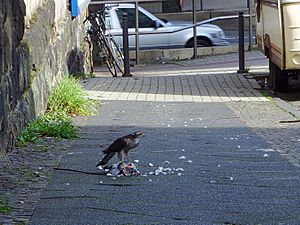Hemerophile facts for kids

Have you ever noticed how some animals and plants seem to do really well in places where humans live or have changed the environment? The word Hemerophile describes these living things. It comes from Greek words meaning "tame-loving" or "culture-loving." These are species that actually benefit from the changes we make to the world around us.
You can often find hemerophiles in what we call "cultural landscapes." This means areas like farms, gardens, parks, and even cities. They are sometimes described as "following humans" because they thrive where human activity is common. Some hemerophiles live so closely with us that they are called synanthropes. This term is used for species that live right in our immediate surroundings, like house mice or pigeons.
Contents
What is a Hemerophile?
A hemerophile is any animal or plant that finds advantages in environments changed by humans. These changes can be anything from building cities to creating farms or even just cutting down forests. Instead of being harmed by human activity, these species find new opportunities to survive and reproduce.
Why do they benefit from humans?
Hemerophiles benefit from human activities in many ways. For example, when we build cities, we create new places for birds to nest, like on buildings or bridges. When we farm, we might create open fields where certain plants can grow easily, or where animals can find food. Our gardens can provide new food sources or shelter.
Examples of Hemerophiles
Many common animals and plants are hemerophiles. Think about the House Sparrow or the Common Pigeon. These birds are very successful in cities because they find plenty of food scraps and safe places to nest on buildings. Other examples include certain weeds that grow well in disturbed soil, or insects that thrive on agricultural crops.
How do they adapt?
Hemerophiles are often very adaptable. They can change their habits, diets, or nesting sites to fit into human-made environments. For instance, some birds learn to eat human food waste, while others might use building materials for their nests. This ability to adapt is key to their success.
Hemerophiles in Different Environments
Hemerophiles can be found in various human-influenced environments, not just big cities.
Farmlands and Fields
In agricultural areas, many plants and animals thrive. Weeds like Dandelions or Thistles often grow well in disturbed soil around farms. Animals like Foxes or Badgers might find food in fields or shelter in hedgerows created by farmers.
Gardens and Parks
Our gardens and parks are perfect spots for many hemerophiles. Birds like Robins and Blackbirds often visit gardens for food and shelter. Many insects, like Ladybugs, also find homes in garden plants. Even some wild flowers that we consider "weeds" are hemerophiles, as they benefit from the regular watering and soil disturbance in gardens.
Urban Areas
Cities are prime examples of hemerophile habitats. Besides pigeons and sparrows, you might see Rats, Mice, or even Raccoons and Coyotes in some urban areas. These animals have learned to find food and shelter among buildings and human waste. Plants also adapt, with some growing in cracks in pavements or on walls.
The Impact of Hemerophiles
Hemerophiles show us how nature can adapt to human changes. While some hemerophiles might be seen as pests, many are just a natural part of the ecosystems we create. Understanding them helps us see how humans and nature are connected, even in our most built-up areas. They remind us that even small changes we make can have a big impact on the living world around us.


